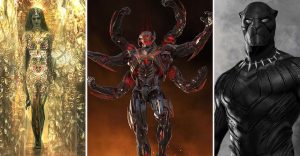Why Alien Resurrection’s Newborn Alien Design Was So Disappointing

Alien Resurrection‘s disappointing Newborn alien design is a major part of why it was a failure both critically and commercially. Fans of the Alien movie franchise are notably hard to please, and the first two movies, Alien and Aliens, have set a standard that is hard to surpass. The prequels, Prometheus and Alien: Covenant, have not had it any easier, despite being far superior to Alien Resurrection. Both prequels have been regarded by some as a disappointment in terms of the Xenomorph, but neither to such an extent as Alien Resurrection in terms of the Newborn alien design.
Ridley Scott once stated that the classic Xenomorph character had been fully “cooked“, and he believed audiences would prefer something new. For him, the prequels were a chance to explore the Xenomorph’s origins and see how audiences would respond to Alien movies without the alien. Subsequently, Scott realized that audiences actually want to see more of the classic Xenomorph, not less, and that it would be a mistake to remove it completely. Alien Resurrection’s Newborn alien design is an example of a similar mistake.
For most fans, a bit of tampering with the original Xenomorph can be acceptable, but the Newborn alien design simply went too far, and is almost a parody of the original. The Newborn alien design is disappointing mostly because it doesn’t inspire the same fear and revulsion as the original and, in some ways, seems more like the Pumpkinhead creature than a Xenomorph. It’s creamy white in color, has a comically human face, and laughably bonds with Ripley 8, who is a clone of the series’ archetypal feminine hero and should be a strong contrast in every way to the Xenomorph. Instead, the Newborn sees her as its mother, and they even share DNA, making them more similar to each other beneath the surface than different. This relationship doesn’t even remotely inspire the same antagonistic feelings that the original Xenomorph did.

The Newborn, because of its combination of human and Xenomorph DNA, seems incomplete and half-formed; in other words, an aberration. The endoparasitic growth and development of the original Xenomorph is a part of what made it so horrifying and is one of the major elements missing from the Newborn’s design. The Newborn is birthed from the womb of a genetically altered Xenomorph Queen, and it doesn’t seem to have a next stage of development. In short, its human qualities—from its face to its movements to its behavior toward its historic enemy, Ripley—are what make it much less fearsome than the original.
The result of the Newborn’s design is something slightly less than horrific: horrifying in its ugliness, but also far more sad and loathsome in its unnatural combination of human and Xenomorph DNA. The Newborn is more a Frankenstein’s monster than a Xenomorph, because it is more the result of the unwieldy and imprecise tamperings of humans than it is the result of Nature’s cruel and unforgiving perfection. The events of Alien: Covenant reveal the Xenomorph’s origins — they’re actually not Nature’s creation, but the android David’s. Despite this, it still evokes a natural horror because of how precisely it interacts with other life forms. This violent precision is arguably the result of David’s analytical perception of biological development, which often relies on the destruction of life to create life.
In this way, Alien: Covenant is a correction of Alien: Resurrection, despite its being a prequel. In Alien Resurrection, the disappointing design of the Newborn alien shows how unique the original Xenomorph is both inside and outside the context of the movies; it is something that the humans could never create on their own, as well as a singular design that could only be created by the minds of artists H.R. Giger and Ridley Scott. In Alien: Covenant, the Xenomorph gets an origin story that is neither natural nor human, but reincorporates the classic Xenomorph in a new way that is far more satisfying than the disappointing design of the Newborn alien in Alien Resurrection.
About The Author


















